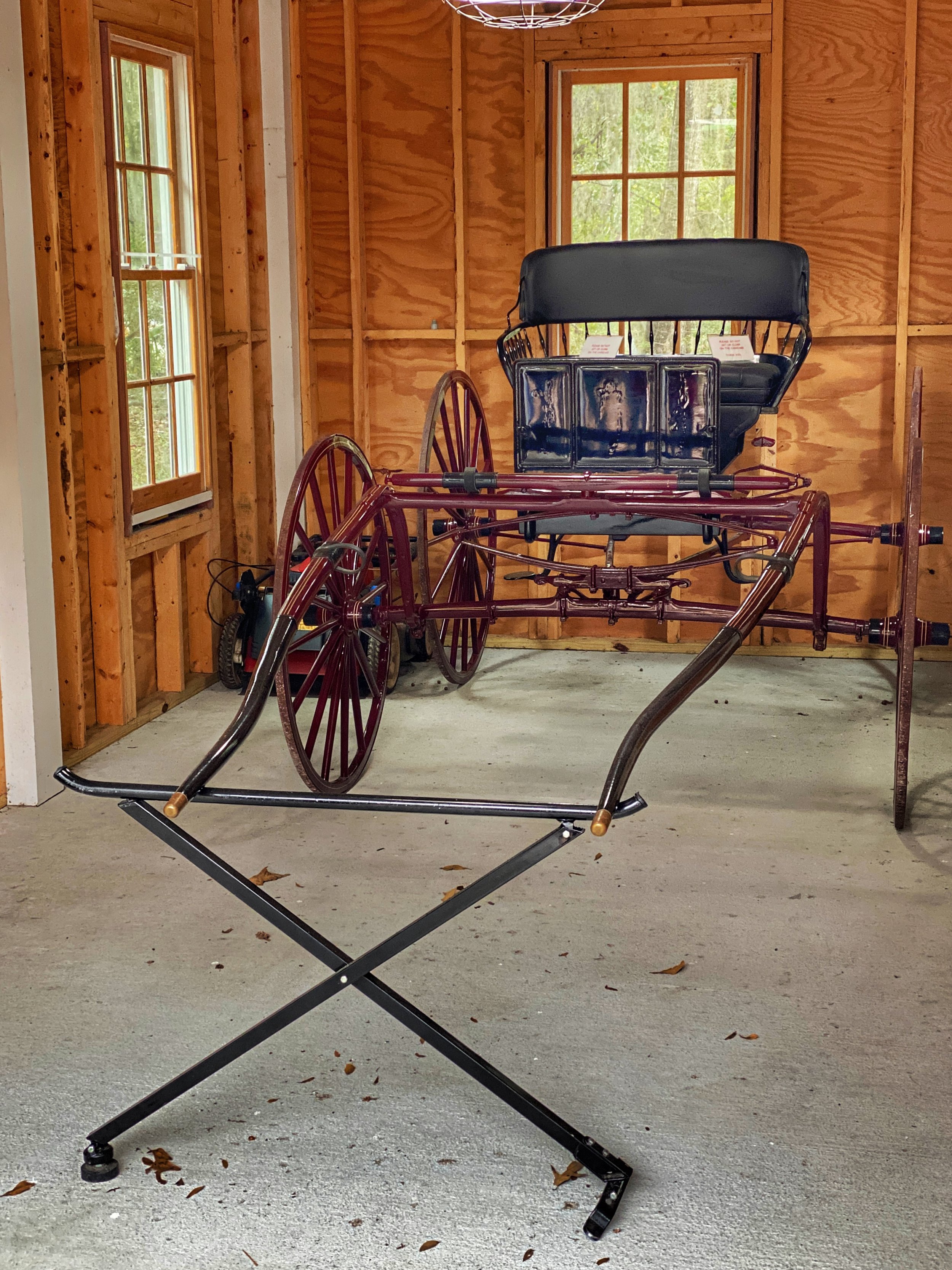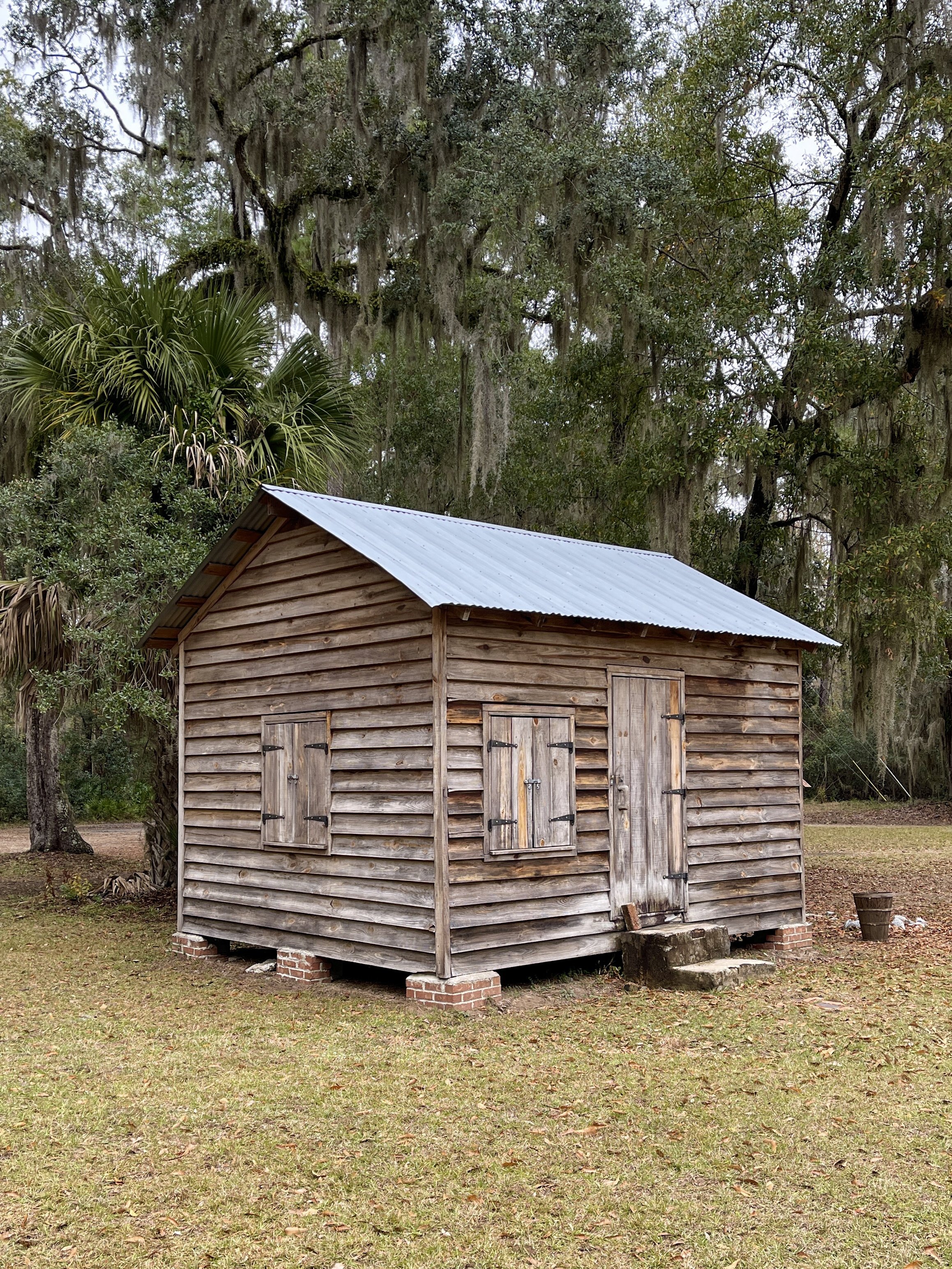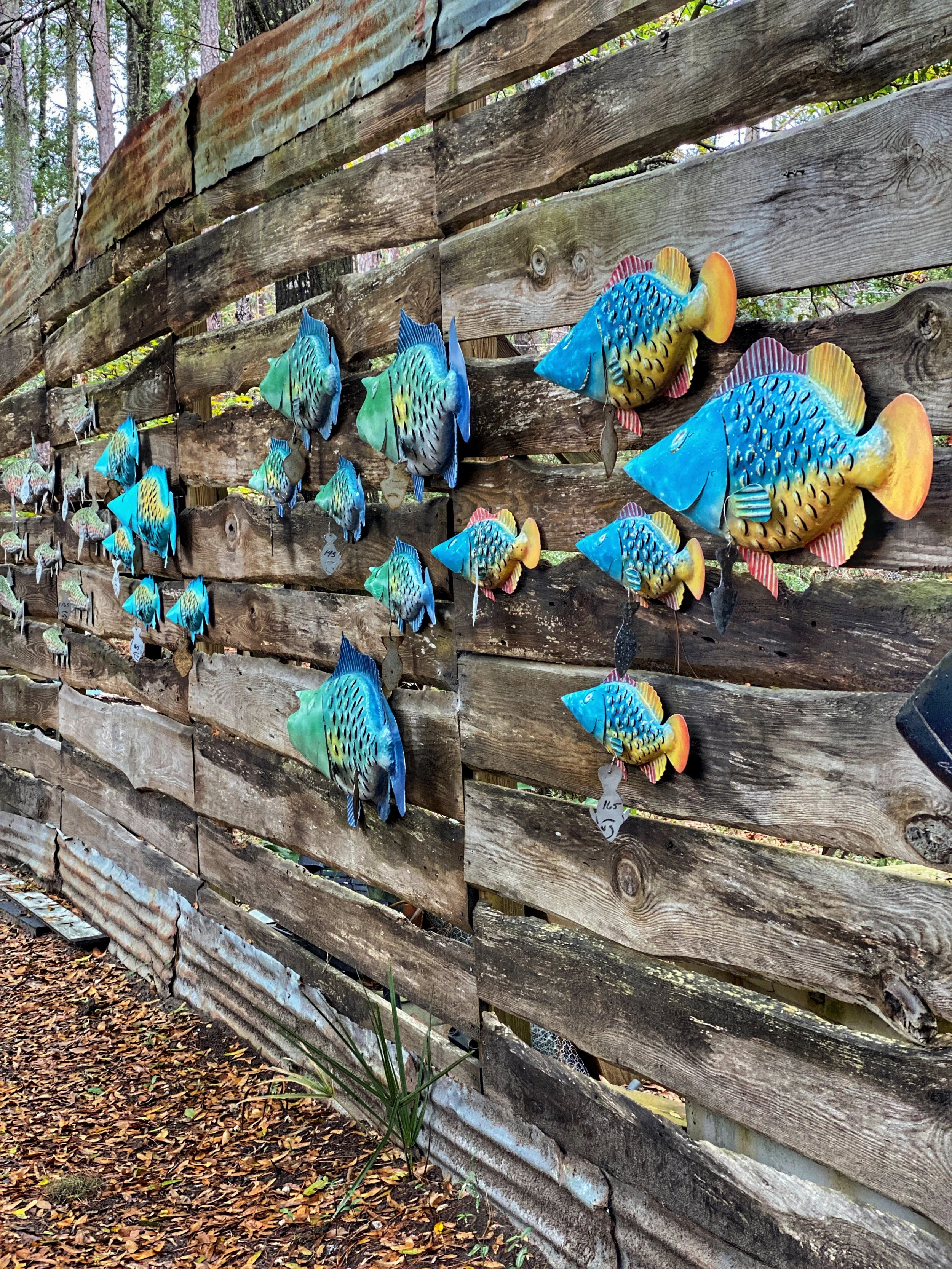Hop in a golf cart and see the real-life Yamacraw Island, South Carolina, including the school where author Pat Conroy taught and the history museum, with stops at Daufuskie Soap Company and the Iron Fish. And stop by the Old Daufuskie Crab Company before catching the Daufuskie Island Ferry back to the mainland.
Daufuskie doesn’t have a bridge to the mainland, so your only option to visit is by boat.
For years, Wally and I have wanted to visit Daufuskie. The remote southernmost Sea Island is tucked away between Hilton Head, South Carolina and Savannah, Georgia.
What was the appeal? The small island retains the rich history of the Gullah-Geechee people, descendants of West and Central African slaves brought to the region and forced to work on Lowcountry plantations. It also boasts a small but thriving makers community — but I’ll get to that later.
There’s no bridge connecting Daufuskie to the mainland, and the only way to reach it is by ferry or water taxi. Last year, rain prevented us from going, and before that it was closed to tourism due to the coronavirus pandemic.
A day trip to Daufuskie is a good excuse to get out on the water. The Daufuskie Island Ferry leaves from this dock by a distinctive failed restaurant just over the bridge from Hilton Head.
This December we booked a guided History and Artisans Tour with local operator Tour Daufuskie and took the 45-minute ferry ride from Buckingham Landing just off of Hilton Head. Roundtrip rides cost $50 per person.
Gullahs, descendants of slaves, once made up most of the population of Daufuskie. Now few remain. Their cemeteries were by the water so their spirits could travel back to Africa.
What Daufuskie?!
According to local lore, Daufuskie got its name from the Gullah “Da Fus Cay,” meaning “the first key (or island).” However, we were disappointed to learn that the name actually comes from the island’s first inhabitants, the Muscogee, or Creek, Indians. In their language, daufa means “feather” and fuskie “pointed.” Combine the two, and you have something that translates to “Pointed Feather,” a reference to the island’s distinctive shape.
Once Wally and I disembarked at Freeport Marina, we met our guide Ryland, who was waiting for us at the end of the boardwalk. We were provided with golf carts and given a quick tutorial on how to use them. There are very few cars on the island. Golf carts and bikes are the preferred modes of transportation.
At the first stop, Ryland told us a bit about the island’s history. Ancient piles of oyster shells, and artifacts such as pottery fragments and arrowheads left by the indigenous Muscogee and Yemasse tribes were discovered by archaeologists on Daufuskie — with some dating as far back as 7000 BCE.
RELATED: The Sea Pines Shell Ring Mystery
This old schoolhouse now serves as the first stop on a tour of the history of Daufuskie — and acts as the community’s library.
An Education at the Jane Hamilton School
Our tour began at the Jane Hamilton School, part of the Billie Burn Museum complex. The one-room schoolhouse was built in the late 1930s using blueprints provided by Julius Rosenwald, head of the Sears, Roebuck and Company mail order empire. Rosenwald was a philanthropist who met renowned educator and prominent African American thought leader Booker T. Washington and recognized the need for educational facilities for disadvantaged Southern Black children. This sparked a transformative collaboration between the pair, and a program emerged to construct modest educational buildings, which later became known as Rosenwald Schools.
Kids used to go to school here until 5th grade, when they’d have to work their family’s farm full time.
The Jane Hamilton School provided education from kindergarten to 5th grade. As this was built at the tail end of the Great Depression, Rosenwald was unable to provide the raw materials required to build the facility. It was financed using money raised by the island community and erected by local craftsmen and workers employed by the government-funded Works Progress Administration (WPA) — with some help from the children themselves.
The school year started in September and ended in March, Ryland informed us. Most Gullah families could not afford to send their children to the mainland to continue their education. Once they completed 5th grade, they were expected to work on the family farm full time. (This prompted some kids to purposely fail to prolong their education, according to our guide.) Today the former school is home to the Gullah Learning Center and the community library.
An Alligator and Gullah Bible at the Daufuskie Island History Museum
The next stop was Mount Carmel Baptist Church Number 2, so named because the first was destroyed by a hurricane in 1940. It’s now home to the Daufuskie Island History Museum. Among the artifacts on display are a taxidermied 11.5-foot alligator, a 19th century Gullah Bible, Indian arrowheads and a restored 1890s pump organ. The museum also has a nook that sells books about the island’s history.
Wally poses by Al, the taxidermied alligator on display.
The history museum has a jumble of artifacts, including a charming pump organ and a Bible written in Gullah. Here’s John 3:16: “Cause God lob all de people een de wol sommuch dat e gii we e onliest Son.”
Sarah Hudson Grant’s Buggy: A Labor of Love
Our final stop in the museum complex was a small structure sheltering the one-horse buggy of Sarah Hudson Grant. When women went into labor on Daufuskie, they would ask for Mrs. Grant aka Granny to come. She became a midwife in 1932 and was married to the island’s undertaker. When he died in 1962, she stepped in and took his place. Grant charged $5 to deliver a baby or $10 to deliver a baby and do a week’s worth of laundry after.
The horse-drawn carriage used by legendary midwife Sarah Hudson Grant was restored by Amish craftsmen (who painted it black, which they felt was much more proper than red).
Over a 37-year period, Grant “grannied” 130 babies on Daufuskie without losing one — and as the undertaker, she was the last to bid farewell to many. The Gullah said, “Granny bring ’em ’n she tek ’em away.”
With no medical instruments or doctors on the island, locals would holler from one property to another to alert her as to who was going into labor and where — at which point, she would hook her horse Tillman up to the carriage and hurry off to deliver the baby.
Ryland told us that electricity didn’t reach the island until the 1950s, with the first telephone following two decades later, in 1973.
Grant retired in 1969.
Billie Burn Museum Complex
44 Old Haig Point Road
The local Baptist Church is the oldest original building on Daufuskie and has been restored twice.
You Gotta Have Faith: The First Union African Baptist Church
The First Union African Baptist Church was built in 1884 and is the oldest original building on the island. It has served as a place of worship and faith for over a century and was built on the grounds of the former Mary Fields cotton plantation.
The structure has had two major facelifts. The first was in 1952, when the island received electricity. Fixtures were converted from gas to electric, and the second was in 1982, when the foundation was reinforced, as over time the structure had begun to slowly sink into the ground. Even today you can still notice a tilt to the walls and doors.
To become a member of the parish, you had to go on a spirit quest into the woods to commune with God.
When the parish was first established, it wasn’t a traditional church, where you could simply show up and attend. You would have to go to the church leaders and tell them you were interested in joining the congregation. They would instruct you to find a quiet place in the woods to pray, and while there, you would hopefully receive a message from God. You’d report back, and a spirit guide would be summoned to interpret your vision. If they weren’t convinced, you’d have to try again, because God (and the church) wasn’t quite ready for you.
Members of the congregation had assigned seating. Men sat on one side and women on the other. The church was the head of the community, in charge of law enforcement, finances and school openings. If you did something that made the community angry, you would be seated in the back, so that everybody knew you were being scorned.
The Praise House on the grounds of the church was a gathering place for slaves, where religious services were held.
Praise You at the Praise House
Tucked to the side of the First Union African Baptist Church stands a simple, weathered wood structure. It’s a reproduction of the original “praise house” that stood there for more than a century. These structures were intentionally built small to prevent large gatherings of slaves, as plantation owners feared that they could easily be overthrown or killed.
When the house was open, the deacon or worship leader would stand on the top step or in the doorway, and most slaves would gather to sit outside on the grass. Those members of the congregation inside the praise house would rhythmically stomp upon the wooden floors, creating a communal drum of sorts.
Singing was an important element of the services and hymns were often sung in round, a short musical piece in which multiple voices sing the same melody but start the song at different times. Services also included songs known as call and response, where the leader would sing out a phrase that was answered by the congregation. These buildings might have been called praise houses, but because of the cacaphony heard during services, plantation owners referred to them as shout houses.
First Union African Baptist Church
School Road
Daufuskie Soap Company started out on a porch like other artisan workshops on the island.
Peachy Clean at Daufuskie Soap Company
Part of the tour was to visit local artisans (those makers I mentioned earlier). One of them is Jan Crosby, who makes soap, lotions and other body care products inspired by the scents of the island. Before we entered the shop, Ryland told us it was originally named Daufuskie Peach — a nod to Crosby’s native roots in Georgia. Like most artisans on the island, she started out by creating a workshop on her porch. Tired of people expecting a fruit stand, Crosby has since changed the name. We purchased a bar of sandalwood soap.
Daufuskie Soap Company
228 School Road
Stop by Daufuskie Blues to see some amazing patterns — and ask for a demonstration.
Indigo Immersion at the Mary Fields School
A short golf cart ride from the church is the Mary Fields School, where local celebrity Pat Conroy taught schoolchildren in 1969. The historic schoolhouse was built in 1933 and now contains Daufuskie Blues, a shop selling indigo-dyed clothing.
RELATED: How Indigo Is Made
For 20 years, the school had no cafeteria or lunchroom. Eventually one was built in the back, and it’s now School Grounds Coffee. We greatly appreciated the chance to get a caffeine fix on an island that doesn’t offer much in terms of places to eat.
The two-room schoolhouse where Pat Conroy once taught is now an indigo shop, art studio and coffeeshop.
Kindergarten through 3rd grade were taught by Mrs. Brown in one room, and 4th through 8th grade by Frances Jones in the other. When Jones retired in 1969, she was replaced for one year by the late novelist Conroy. Fresh out of grad school, he wanted to come to Daufuskie to teach, inspire and motivate students. But his methods were unconventional — and controversial. He would regularly take students over to the mainland to places like Bluffton, Savannah and even Washington, D.C. At the end of his first year teaching, Conroy was fired. He went on to write an autobiographical book about his time at the Mary Fields School called The Water Is Wide, adapted into a movie starring Jon Voight named Conrack, which is how the Gullah children pronounced Conroy’s name.
Conroy never returned to teaching, but he did keep in contact with his students and continued to write. Ryland added that even though Conroy was forced out of the school, he made out all right, going on to have a successful literary career, penning bestselling books like The Great Santini and The Prince of Tides.
Daufuskie Indigo
School Grounds Coffee
203 School Road
Chase Allen’s artwork has gotten quite popular and won an American Made award from Martha Stewart Living.
Reeling in Art at the Iron Fish
Our final stop was the Iron Fish, where a whimsical menagerie of fish, mermaids, stingrays and other coastal creatures fashioned from distressed sheet metal are displayed in the open-air gallery owned by artist Chase Allen.
Allen has an outdoor workshop on the island.
Payment is on the honor system.
Allen asks patrons to pay by the “honor system”: Leave a check in the box on his front porch or make a mobile payment through Zelle.
The Iron Fish
168 Benjies Point Road
The Old Daufuskie Crab Company has a great outdoor space — but it was too cold to enjoy when we visited in December. It’s one of only a couple of restaurants that stay open all year.
Lunch Stop at Old Daufuskie Crab Company
Our two-hour tour wrapped at 1 p.m., so Wally and I wanted to grab some lunch before catching the 2:30 ferry back to the mainland. We decided it’d be best to get back by the harbor, so we stopped into the Old Daufuskie Crab Company. We ordered beers and a basket of spicy shrimp — but passed on the “scrap iron,” an Arnold Palmer-esque cocktail made with moonshine.
Old Daufuskie Crab Company
256 Cooper River Landing Road
Ryland, with Tour Daufuskie, was a storehouse of interesting local knowledge. The poor guy is only one of a few people his age on the island.
A visit to Daufuskie is a great day trip if you’re in the Hilton Head or Bluffton area. You get to be on the water, tool around in golf carts and learn some fascinating Gullah history. And you couldn’t hope for a better guide than Ryland. We enjoyed spending time with him and were impressed with his knowledge of the island. While the weather was a bit cold on our visit in December, we were happy to finally have made it to Daufuskie. We’ll be back. –Duke
RELATED: Gullah History of Hilton Head








































